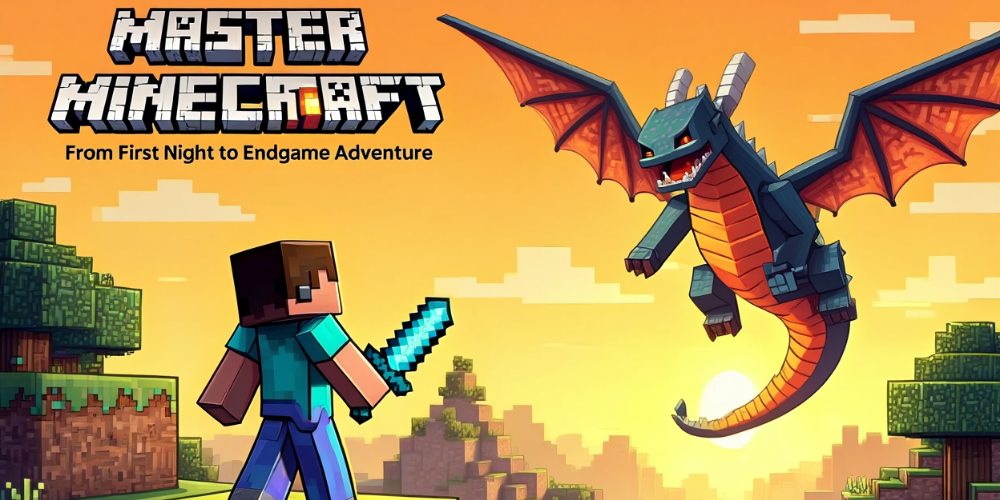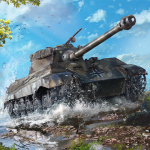Master Minecraft: From First Night to Endgame Adventure
2025-08-25

Want to turn your first night from panic into power? This friendly guide shows you how to go from punching your first tree to flying with an elytra. You will learn fast, avoid common mistakes, and keep your world safe and fun as you grow.
Minecraft is a sandbox with many paths: beat the Ender Dragon, build a mega base, or master redstone. This step-by-step guide gives you a clear route through survival, building, mining, combat, trading, and travel, so you always know your next move.
Getting Started: Game Modes and Goals
Minecraft has different modes. Pick the one that fits your mood and time.
- Survival: Gather, craft, fight mobs, and manage hunger. This guide focuses on Survival.
- Creative: Infinite blocks, no damage. Great for learning builds and redstone.
- Hardcore (Java): One life, hard difficulty, world deletes on death. For experts.
Your main goals can be simple or big. A good early route is: survive your first nights, get iron and food, upgrade gear, visit the Nether, find a stronghold, and defeat the Ender Dragon. After that, explore the End Cities for elytra and shulker boxes, build farms, and create your dream base.
Your First Day: Tools, Shelter, Food
The first 10 minutes matter. Move quickly and keep it simple.
- Punch a tree and collect logs. Open your inventory and craft a crafting table and sticks.
- Make a wooden pickaxe, then mine stone. Immediately upgrade to stone tools (pickaxe, axe, shovel, sword or axe for combat).
- Craft a furnace and torches. Smelt food and light your shelter to stop mob spawns.
- Look for sheep to craft a bed (3 wool + 3 planks). Sleep the first night to skip mobs.
- Gather basic food: kill a few animals, grab apples from trees, or punch grass for wheat seeds.
- Build a small shelter or dig into a hill. Place a door, torches, a chest, bed, and crafting table.
- Press F3 (Java) or check your map (Bedrock) to note your coordinates. This helps you return home.
Smart Crafting Basics
- Crafting Table: 4 planks. Your core tool for recipes.
- Sticks: 2 planks. Needed for tools and torches.
- Tools: Start stone, then iron as soon as you can.
- Furnace: 8 cobblestone. Smelt ores and food.
- Torches: 1 stick + 1 coal/charcoal. Place often to prevent mobs.
- Chest: 8 planks. Keep items safe.
- Bed: 3 planks + 3 wool. Set your spawn point.
- Shield: 1 iron + 6 planks. Essential for blocking skeletons and creepers (Java). In Bedrock, shields also help a lot.
Mining and Progression
Mining gives you iron, diamonds, and other key resources. Go step by step and stay safe.
- Start with iron. Look in caves or dig a staircase down. Smelt iron ore into ingots for a pickaxe, armor, and a bucket.
- Use a water bucket to stop fall damage and turn lava into obsidian.
- Diamonds spawn deep underground. A common target is around Y -58 (Java/Bedrock may vary by version), but any deep area below Y 0 can work. Bring lots of torches.
- Branch mining: Dig a main tunnel, then small side tunnels every two blocks. This is safe and efficient.
- Caving: Light up as you go. Place torches on the right side so the left side leads you out, or vice versa.
- Do not dig straight down or straight up. Lava and gravel can kill you.
- Upgrade path: stone tools → iron armor/tools → diamond tools/armor → netherite upgrades (using ancient debris from the Nether).
Combat and Safety
Mobs spawn in dark areas. Good lighting and a shield reduce most danger.
- Always carry: shield, water bucket, food, torches, a few blocks, and a spare pickaxe.
- Use a shield against skeleton arrows and creeper blasts. Block, step back, then strike.
- Axe vs Sword: Axes hit harder but swing slower (Java). Swords have faster attacks and sweep damage (Java). In Bedrock, timing is different, but both weapons work.
- Bow or crossbow helps with creepers, skeletons, and Endermen from a safe distance.
- Wear at least iron armor before long cave trips. Enchantments like Protection, Feather Falling, and Unbreaking save your life.
- Spawn-proof your base: place torches or use other lighting so mobs cannot spawn.
Farming, Food, and Villagers
Food keeps you alive and lets you heal. Farms also give steady resources. Villagers can trade powerful gear and books.
- Crop farms: Plant wheat, carrots, potatoes near water. Use a hoe to till soil. Bone meal speeds growth.
- Animal farms: Breed cows, sheep, chickens, and pigs for food and materials. Use wheat (cows, sheep), carrots/potatoes (pigs), seeds (chickens).
- Melons and pumpkins: Easy early farms; good for trading with villagers.
- Sugar cane: Grows by water. Needed for paper (books, maps, rockets).
- Villagers: Cure a zombie villager (weakness potion + golden apple) to get big discounts. Job blocks set trades (lectern for librarian, blast furnace for armorer, etc.).
- Best trades: Librarian for mending/unbreaking, toolsmith/armorer for diamond gear, fletcher for easy emeralds.
Exploration and Travel
Exploring finds new biomes, structures, and loot. Plan your trips.
- Make a map and compass. A compass points to world spawn; maps help you record land.
- Use boats for fast water travel. Boats are cheap and safe (also carry mobs if needed).
- Horses can be fast on land once you find a saddle. Later, elytra makes flying easy.
- Mark your path with torches, signs, or pillars. Write down coordinates for your base.
- Look for structures: villages (food, trades), shipwrecks and ruins (loot), temples (be careful with traps), mineshafts, and towers.
- Bring a bed to skip nights on trips, but do not sleep in the Nether or End (it explodes).
Nether and End Roadmap
The Nether and the End unlock late-game tools and the final boss. Prepare first.
- Nether portal: Mine obsidian with a diamond pickaxe. Build a frame and light it with flint and steel.
- Gear up: Wear at least diamond armor, a shield, and bring a bow. Bring gold armor to prevent piglins from attacking.
- Key nether goals: Find a nether fortress for blaze rods. Trade or hunt ender pearls (barter gold with piglins or kill Endermen).
- Brewing: Use blaze powder to fuel a brewing stand. Make fire resistance potions for lava and strength potions for combat.
- Eyes of Ender: Craft with blaze powder + ender pearls. Throw them to locate the stronghold, then place them in the End portal frames.
- Ender Dragon fight: Destroy crystal towers (shoot or climb), avoid dragon breath, use beds as explosive damage only if you know the trick. Place water to save yourself from knockbacks.
- After the dragon: Collect dragon egg as a trophy. Find End Cities and ships for elytra and shulker shells (shulker boxes = portable storage).
Enchanting, Potions, and Gear Upgrades
Enchantments and potions make you safer and faster. They also save tool durability.
- Enchanting table: Needs bookshelves around it (15 shelves for max level 30). Use lapis lazuli to enchant.
- Best armor enchants: Protection, Unbreaking, Mending, Feather Falling (boots), Depth Strider or Frost Walker (boots).
- Best tool enchants: Efficiency, Unbreaking, Mending, Fortune (for ores) or Silk Touch (for blocks). Use an anvil to combine books and items.
- Weapons: Sharpness or Smite, Power on bows, Infinity or Mending (usually pick one), Looting on swords, Sweeping Edge (Java).
- Potions to brew: Fire Resistance (Nether safety), Strength (combat), Swiftness (travel), Night Vision (caving), Water Breathing (ocean ruins), Slow Falling (End fight).
- Grindstone removes bad enchants. Keep backups of key tools in a chest.
Redstone Basics and Useful Builds
Redstone is Minecraft “electricity.” Start small and learn by doing.
- Core parts: redstone dust (wiring), levers/buttons/pressure plates (power sources), pistons and sticky pistons (movement), observers (detect changes), repeaters (delay/extend signal), hoppers (item flow), comparators (read container signals).
- Beginner builds: automatic sugar cane farm (observer + piston), pumpkin/melon farm (observer + piston), item sorter (hoppers + comparators), simple mob-free doors.
- Water streams and hoppers move items; note that too many hoppers can cause lag on servers.
- Test in Creative if unsure. Copy small designs first, then expand.
Building Better Bases
Your base should be safe, useful, and nice to look at. Plan zones and grow slowly.
- Location: Near a village, ocean, or multi-biome area gives variety. Flat space helps for farms.
- Lighting: Torches, lanterns, glowstone, or other blocks to stop mob spawns. Light roofs and caves under your base if needed.
- Storage: Make a labeled storage room early. Keep valuable items near your bed and an ender chest when you get one.
- Portal room: Build a safe Nether portal area with walls, doors, and gold armor spare.
- Design: Pick a palette of 3–5 blocks that match (for example: spruce, stone bricks, and cobble). Add depth with stairs and slabs.
- Farms nearby: Crop fields, animal pens, sugar cane line, and a small tree farm keep daily tasks easy.
- Security: Fences, walls, or moats keep mobs out. Cats reduce creeper risk in villages.
Multiplayer and Etiquette
Playing with friends or on servers adds rules and teamwork.
- Ask before building near others. Respect claims and protected zones.
- Do not grief, steal, or spam. Keep chat friendly.
- Trade fairly. Share portals and public farms if rules allow. Replant crops you harvest.
- Lag awareness: Massive farms or redstone can hurt server performance—build responsibly.
- Use signs, chests, and community boards to communicate and organize group projects.
Performance and Settings
Good settings make the game smoother and safer.
- Lower render distance and fancy graphics if your FPS is low.
- Turn down particles and clouds on weaker PCs.
- Use full brightness for caving if you prefer clear vision.
- On Java, performance mods like Sodium/Fabric or OptiFine can help (if you use mods). On Bedrock, use in-game performance options.
- Back up your world before big trips or risky builds.
Common Mistakes and How to Avoid Them
- Digging straight down/up: Always dig in a staircase or dig two blocks and stand between them.
- No water bucket: Always carry one. It saves you from lava and falls.
- Forgetting coordinates: Note your base location early. Use signs or a screenshot.
- Fighting Endermen without cover: Make a 2-block-high shelter to fight them safely.
- Sleeping in the Nether or End: Beds explode there. Do not try it unless you know what you are doing.
- Angering piglins: Wear at least one gold armor piece in the Nether. Do not open chests near piglins unless you are ready to fight.
- Portal confusion: Nether coordinates scale 1:8 vs Overworld. Link portals by dividing/multiplying coordinates by 8.
- Ignoring shield: A cheap shield can save you from most early deaths.
- Bad enchant combos: Do not mix Silk Touch and Fortune on the same tool. Keep separate tools.
Fun Goals to Keep You Motivated
- Beat the Ender Dragon and collect the dragon egg.
- Get elytra and build a rocket factory (sugar cane + gunpowder farm).
- Create a map wall of your world or a museum of rare items.
- Build a themed base (medieval village, modern city, underwater dome, sky island).
- Automate simple farms: iron farm, kelp smelter, or mob farm.
- Master redstone with a door, secret entrance, or storage sorter.
- Visit every biome and finish in-game advancements.
- Hardcore challenge (Java) or “no death” challenge in normal survival.
Conclusion
Minecraft is about steady progress and creative ideas. Start small, learn each system, and take safe risks. With a shield, water bucket, good lighting, and smart planning, you can explore, build, and win without fear.
Quick final tips: set your spawn, carry the basics, keep backup tools, mark your routes, and write your coordinates. Use villagers for mending books, bring fire resistance to the Nether, and place chests often so you never lose everything. Have fun, stay curious, and let your world grow with you—block by block.




Leave a comment
Your comment is awaiting moderation. We save your draft here
0 Comments